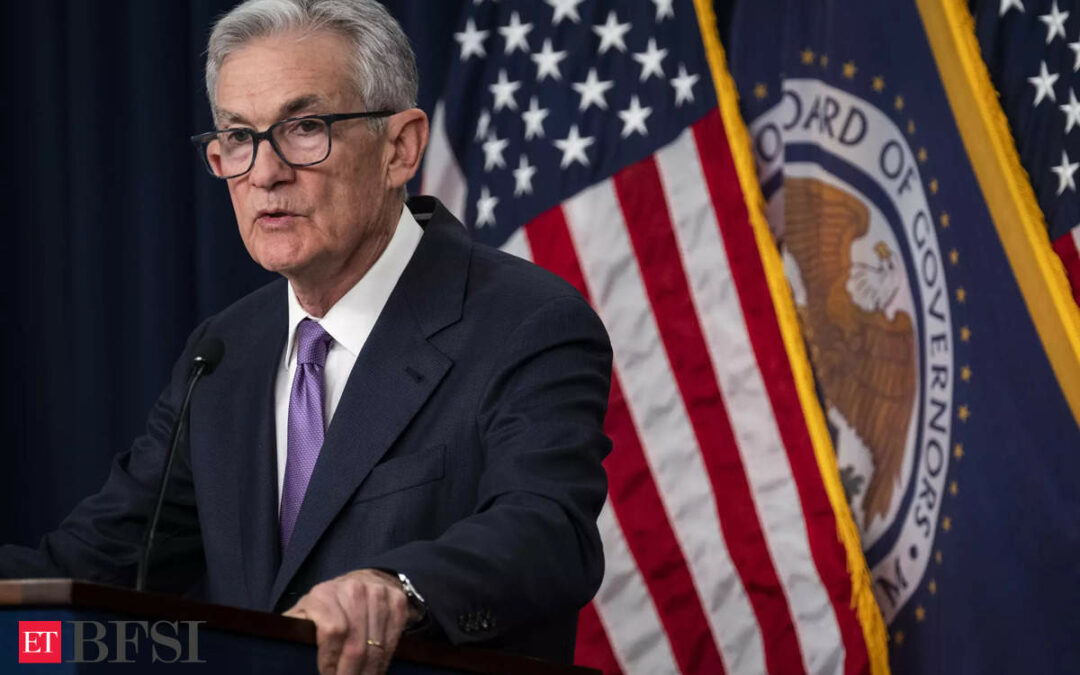The coming 12 months are shaping up as the year of the interest-rate cut.
After racing ahead with the most aggressive tightening campaign in decades during 2022 and 2023, central banks around the world are poised to begin easing monetary policy as inflation continues to retreat.
The shift is captured by Bloomberg Economics, whose aggregate gauge of rates across the world shows a decline of 128 basis points over the year, mostly led by emerging economies.
Among such central banks, those in Brazil, the Czech Republic and others have already started that process.
The US Federal Reserve will lead the pivot for richer countries after its policy makers signaled 75 basis points of cuts for the year, marking an abrupt shift from previous warnings that rates could still go higher through much of 2024.
Others, such as the European Central Bank, are more reticent to signal cuts, but Bloomberg Economics expects the first easing there is likely to materialize in June. Markets are betting the Bank of England will cut that month too.
Japan will remain the standout among its peers, with Governor Kazuo Ueda expected to tighten policy at last, by ending the world’s last negative rate.
For emerging economies, Argentina and Russia are set to push through steep rate cuts. Mexico’s central bank, which had been resisting such action, is also expected to begin easing, according to Bloomberg Economics analysis.
What Bloomberg Economics Says:
“Central banks are looking forward to a victory lap as inflation tracks back to target with only a modest blow to growth. Markets cheering the policy pivot will provide the appropriate soundtrack. The reality, though, is that monetary policy didn’t have much to do with post-pandemic price pressure on the way up, and can’t claim too much of the credit on the way down. One takeaway is that central bank tools are narrow, and the sources of inflation risk wide.” — Tom Orlik, global chief economist
Plans to bring down rates hinge on inflation continuing to slow. Skeptics warn that prices mostly remain some way from central-bank targets, and that policy will need to remain tight.
Still, readings on both headline and core inflation continue to cool, led by goods prices with the services sector expected to follow, allowing officials to begin taking steps to ease the burden of borrowing costs on households and businesses.
Here is Bloomberg’s quarterly guide to the outlook for the world’s top central banks, which set rate policy for a combined 90% of the global economy.
GROUP OF SEVEN
US Federal Reserve
Most Fed officials expect to cut rates this year, starting to unwind the most aggressive tightening campaign in four decades in response to falling inflation. But they’ve also emphasized that their moves depend on making further progress on prices, and will be guided by incoming data.
Policymakers forecast lowering rates by 75 basis points to 4.6% in 2024, according to the median projection released in December. Futures markets, however, are betting the Fed will cut rates six times this year, beginning with a likely quarter-point reduction in March.
Fed Chair Jerome Powell and several of his colleagues have stressed that the central bank can “proceed carefully,” suggesting they’re not in a rush. Powell said at his December press conference that it was premature to declare victory, though he acknowledged that the question of when to begin “dialing back” policy restraint had been discussed.
What Bloomberg Economics Says:
“The Fed has reached the end of its hiking cycle. With core inflation looking to be on track to approach Fed’s 2% target — by some key metrics – in March 2024, the FOMC likely will be able to respond to faltering growth and rising unemployment with a first rate cut then. We expect another 100 bps of cuts in the rest of the year, bringing the upper end of fed funds rates at the end of 2024 to 4.25%.”— Anna Wong
European Central Bank
In contrast to the Fed, ECB officials are loathe to talk about the possibility of rate cuts. Despite inflation having receded much more forcefully than imagined, concerns remain about the pace of wage increases in the 20-nation euro zone. Clarity on whether such trends are cooling is unlikely before the second quarter of 2024.
Governing Council members have refused to countenance any imminent cut — going up against market bets for a reduction within months as the region’s economy flirts with its first recession since the pandemic.
The key now will be whether Europe experiences a mild downturn that would still count as a soft landing, or whether the lingering knock-on effects of the ECB’s unprecedented ramp-up in borrowing costs trigger a slump harsh enough to shift monetary-policy settings earlier than planned.
What Bloomberg Economics Says:
“The ECB has finished hiking. Underlying inflation is falling, surveys are pointing to a significant deterioration in activity and credit extension is weaker than it was in the depth of the euro crisis. In addition, the mood music has changed globally. Unless the economy were to tank, the ECB will still need time to be satisfied that inflation is on the right trajectory. We expect the first cut in June 2024. However, the risks are heavily skewed toward earlier action.” —David Powell
Bank of Japan
The question for Bank of Japan watchers is when it will end the world’s last negative rate, not if. After succeeding in transforming the yield curve control program into a flexible insulator against sudden yield rises in his first year at the helm, Governor Kazuo Ueda will now parse incoming data to assess the stability of inflation trends.
An earthquake on New Year’s day convinced the minority of economists predicting fast action on rates to push back their timelines to match the mainstream view, which sees the bank’s first rate hike since 2007 coming in April. The preliminary results of spring pay talks in March will garner the most market attention in years, as the BOJ has made it clear that’s one of the key factors in its pursuit of a virtuous wage-inflation cycle.
What Bloomberg Economics Says:
“The BOJ has ramped up its communications efforts to set the scene for an eventual exit from YCC and negative rates. But it’s in no rush to make a move. What we still haven’t seen are clear signals from wages and inflation data that would convince the BOJ that its 2% target is secure. We see transition to a new framework occurring in the second half of 2024, most likely in July.”—Taro Kimura
Bank of England
Traders have also ramped up bets on a cut arriving as soon as May, despite BOE Governor Andrew Bailey insisting that it’s too soon to consider a policy pivot.
There’s growing speculation that the BOE will be forced to abandon the higher-for-longer messaging kept at its December meeting, which notably contrasted with more dovish communications from the Fed.
The BOE is likely to lower its inflation forecasts at the next meeting on Feb. 1 after November’s reading came in much lower than expected at under 4%.
While the UK may have suffered a minor recession in the second half of 2023, its growth picture is beginning to brighten. The BOE’s new projections could reflect lower borrowing costs expected by markets, softer inflation prints, and growing wages in real terms. The central bank will also provide its annual assessment of the economy’s medium-term growth potential in February.
What Bloomberg Economics Says:
“The outlook for CPI inflation has improved dramatically in recent months. We think it will fall below the BOE’s 2% target in the spring, providing ample space for the central bank to start easing. The first cut is likely to come in May, with rates ending 2024 at 4%.”—Dan Hanson
Bank of Canada
While Bank of Canada Governor Tiff Macklem has repeatedly said it’s too early to discuss cuts, economists and markets see the central bank starting to lower borrowing costs by the second quarter. In December, policymakers kept them unchanged for a third consecutive meeting, acknowledging a stalling economy while still keeping the door open to further hikes in case core inflation proves sticky.
How Canada’s highly indebted households continue to fare amid the highest rates in two decades remains a key consideration. Their shorter duration home mortgages roll over more quickly than those of their American counterparts, a big reason why economists see the country’s economy as more rate-sensitive.
Still, Macklem will likely be less inclined to declare victory than his peers. At the start of 2023 the central bank paused to assess the impact of its rate-hike cycle, prompting markets to immediately price cuts and contributing to a resurgence of inflationary housing activity. That’s not something they’ll want to risk repeating this time around.
In a recent summary of deliberations of the December meeting, the six members of the bank’s governing council increasingly agreed that rates were “sufficiently restrictive” to bring inflation back to the 2% target, suggesting their conversation is moving from how high to how long borrowing costs should weigh on economic growth. Still, the bank says it needs to see clearer evidence of further and sustained easing in underlying price pressures before rate cuts will be considered.
What Bloomberg Economics Says:
“Households and firms will continue feeling the pinch from higher prices and rates as the labor market cools along with broader economic activity. Though BOC Governor Macklem hinted that a policy pivot is on the horizon, we expect rate cuts to begin later in 1H’24 only after the data indicate the last mile on the road to 2% inflation can be achieved.”—Stuart Paul
Rate Cuts to Follow Further Economic Slowdown
BRICS CENTRAL BANKS
People’s Bank of China
China’s economy is under pressure going into 2024 as domestic and overseas demand continues to falter. The central bank’s modest rate cuts have so far failed to alleviate deflationary threats, as consumer confidence wanes amid a record slump in the property market. While the country looks set to have achieved its roughly 5% growth goal, the next challenge is repeating it this year. That will likely take greater policy support due to a higher comparison base.
The PBOC is expected to cut rates and banks’ required cash reserves moderately, in line with its cautious approach. Expectations for a move on the one-year policy rate in mid-January are increasing following commercial banks’ deposit rate cut last month. The central bank has stepped up financing for the property sector and promised emergency funds to local governments facing huge debt repayments.
What Bloomberg Economics Says:
“The PBOC showed its easing stance with an 800-billion-yuan net cash injection via its one-year medium-term lending facility on Dec. 15, which was a record. Clearly, the economy needs more policy supports, as suggested by weak PMIs and soft inflation, and the central bank will continue to deliver. We expect the PBOC to resume cutting rates reducing banks’ required reserve ratio in 1Q24. The first rate cut can come as early as mid-January.”—David Qu
Reserve Bank of India
Reserve Bank of India Governor Shaktikanta Das wants to see inflation settle around the target 4% on a durable basis before he and other rate-setters consider a pivot.
Projections, though, don’t suggest inflation staying at those levels for long in 2024. Volatile food prices pushed up the consumer price index for the first time in four months in November, and the December print could turn out even higher. Even as monetary policy has very little impact on food prices, elevated rates have managed to moderate a sticky and difficult core.
The RBI’s focus has now shifted to ensuring food spikes are not transmitted to other segments of the economy. The benchmark repurchase rate has remained at 6.5% for five straight reviews through December and may stay there for a while longer while the RBI stamps demand further by making unsecured loans costlier. Growth, though, has surprised with a strong showing, forcing the central bank to raise its forecast by half a point to 7% for the fiscal year that will end in March.
What Bloomberg Economics Says:
“The RBI will cut rates in coming months to counter an incremental slowdown in growth — but only after the Fed moves first. Our US team expects a Fed cut in March. We see the RBI cutting in April and taking the repo rate down 100 bps to a terminal 5.5% by 4Q24. Even so, it’s still likely to keep liquidity tight, possibility by selling government bonds starting in March, to maintain an ‘actively disinflationary’ policy.”—Abhishek Gupta
Central Bank of Brazil
Brazil’s central bank has shaved two percentage points from borrowing costs since August in an easing cycle that most analysts see extending through mid-2024. Board members, led by president Roberto Campos Neto, have pledged to carry on with half-point rate cuts through March.
Headline inflation has slowed to within the monetary authority’s tolerance range, and closely-watched core measures that exclude volatile items like energy and food are also easing. Still, central bankers are opting for a gradual cutting cycle as most analysts bet inflation will stick above the 3% target through 2026. Investor doubts surrounding President Luiz Inacio Lula da Silva’s pledges to eliminate the primary fiscal deficit — which excludes interest payments — are complicating the policymaking outlook.
What Bloomberg Economics Says:
“We expect the BCB to keep the current pace through the May meeting. From then on the BCB will likely proceed more cautiously, with 25-bps moves, as the ex-ante real rate nears the highest estimates for the neutral rate (4.1% to 5.5%, according to a BCB survey). Our forecast of 9% by December assumes that the government will remain ambiguous on fiscal targets, and that the names of the new BCB appointees won’t be known until 3Q24.” —Adriana Dupita
Bank of Russia
After the Bank of Russia more than doubled the key rate in 2023 to 16%, Governor Elvira Nabiullina signaled in December that the end of the tightening cycle may be approaching. Still, she warned that “until we are confident that there is a steady downward trend in price growth and inflation expectations, the key rate will stay high for as long as necessary.”
Policy makers are continuing to grapple with inflation that’s almost double the bank’s 4% target as President Vladimir Putin seeks a fifth term in March elections. Inflationary risks, including elevated budget spending on Russia’s war in Ukraine and a severe labor shortage, are poised to persist.
What Bloomberg Economics Says:
“The Bank of Russia’s key rate has peaked. Policymakers’ next job is avoiding premature easing. While most central banks face the same task in 2024, the Bank of Russia has fresh experience of what this mistake may cost. Its front-loaded easing in 2022 resulted in a ruble rout and drove price growth to triple its 4% inflation target in 2023. If it keeps the policy rate above 12% throughout 2024, inflation will come down to 4.7% year-on-year in December 2024.”—Alexander Isakov
South African Reserve Bank
Even though price growth eased toward the end of 2023, inflationary risks remain at the fore of officials’ concerns, rendering them reluctant to begin cutting borrowing costs. The South African Reserve Bank’s Monetary Policy Committee is seen keeping the key rate unchanged at its two meetings in the first quarter.
Governor Lesetja Kganyago says the central bank will continue to assess risks to the inflation outlook and stands ready to act should they materialize to ensure a return to the midpoint of its 3% to 6% target range, where it prefers to anchor expectations. One such danger could be increasing demands on public finances before elections this year that could weigh on the rand.
What Bloomberg Economics Says:
“The SARB’s unanimous decision to keep the repo rate at its November meeting confirms the hiking cycle has ended. This implies the upside pressure on inflation in the near term will be transitory. We expect inflation to moderately pick up from 5.4% in November and peak in January, and thereafter slow towards the mid-point of the 3-6% target. The central bank is likely to start cutting rates in 4Q when inflation approaches the 4.5% level where the SARB wants it to be anchored.” —Yvonne Mhango
MINT CENTRAL BANKS
Banco de Mexico
Mexico’s central bank, known as Banxico, is the one holdout among Latin America’s major inflation-targeting banks, most of which have already started cutting borrowing costs. Banxico is expected to start an easing cycle early in 2024, with Governor Victoria Rodriguez saying a reduction could come in the first quarter.
Even so, the bank’s board is predicting that inflation won’t fall back to the 3% target until the second quarter of 2025, meaning that any easing will be implemented gradually. Mexico’s June presidential election also stands to bring a new set of price pressures, with additional government spending on public works and the biggest fiscal deficit in over thirty years.
What Bloomberg Economics Says:
“Banxico has held rates at 11.25% since the end of the tightening cycle in May, consistent with tight monetary conditions. Decelerating inflation and lower expectations provide room for some accommodation, but they are poised to remain above the target and limit the downside. Slower growth consistent with a narrowing positive output gap also supports a gradual adjustment. US rates are a risk. We see Banxico slowly cutting rates starting in March, but monetary conditions still tight in 2024.”—Felipe Hernandez
Bank Indonesia
While Bank Indonesia embarked on its post-pandemic tightening cycle with swift and outsized moves, expect it to take more caution in its pivot to easing. Governor Perry Warjiyo has said the central bank will not match the pace set by the Fed, adding that it will have greater clarity to assess its own rate cuts in the second half of 2024.
Chief among the risks are supply-chain disruptions, the El Nino dry spell, and election-related spending that could push up consumer prices. Lingering market volatility could also yet weaken the rupiah, bloating costs for imported goods like oil and rice, just as the lower 1.5%-3.5% inflation target kicks in this year.
What Bloomberg Economics Says:
“Bank Indonesia is likely to cut rates by 125 basis points in 2024, but it won’t move until after the Fed starts easing. Jumping the gun would narrow the rate differential – undercutting the rupiah, which it has worked hard to prop up. Capital inflows are also vulnerable to a reversal if the global slowdown cools risk appetite. Another hurdle is inflation. Bank Indonesia is wary of a breach of its new inflation target. This likely keeps rates on hold in the first quarter of 2024.” —Tamara Henderson
Central Bank of Turkey
Turkey’s central bank is expected to wrap up its aggressive tightening campaign with one last hike in January.
The overall expectation among analysts is for officials, led by Governor Hafize Gaye Erkan, to settle the benchmark rate at 45%. However, a sharp upward adjustment to the minimum wage could prompt a need for higher rates, according to Wall Street banks such as Morgan Stanley and Goldman Sachs.
Local elections in March, seen as a verdict on President Recep Tayyip Erdogan’s rule, could still prompt the central bank to launch an easing cycle earlier than intended. That’s especially so given Erdogan’s preference for pro-growth policies through funneling cheap money as a means to boost electoral support.
What Bloomberg Economics Says:
“Turkey’s central bank is not done hiking. This is even after it lifted borrowing costs by 3,400 basis points in 2023 following its sharp pivot since last May’s presidential and parliamentary elections. We expect the main rate to reach 45% in January from 42.5% currently and stay there through 3Q24 while the central bank delivers additional tightening via alternative tools such as changes to banking regulation.”—Selva Bahar Baziki
Central Bank of Nigeria
Having not met since July, Nigeria’s Monetary Policy Committee under its new governor, Olayemi Cardoso, is widely expected to deliver a large rate hike in the first three months of the year to show its willingness to act.
Inflation that at 28.2% in November matched the record high from 2005 is forecast to continue to accelerate until at least the first quarter due to naira weakness and second-round effects from the removal of fuel subsidies that led to price hikes.
What Bloomberg Economics Says:
“The Central Bank of Nigeria plans on tightening policy in the first two quarters of 2024. We expect the shift to targeting inflation to lift rates by at least 500 basis points in the first half of 2024. The central bank will need to maintain a tight policy until 2025 for several reasons. First, a 500-bp hike would help bring down inflation from 28.2% in November and restore positive real rates by August. Second, outsized rate hikes are required to lower inflation expectations. Third, higher rates will attract the foreign financial inflows that will help converge exchange rates.” —Yvonne Mhango
OTHER G-20 CENTRAL BANKS
Bank of Korea
The Bank of Korea is pushing back against speculation it may follow the Fed in signaling an earlier-than-expected pivot. Governor Rhee Chang-yong has said each central bank now has more scope to set its own course based on domestic conditions, and that the “last mile” of the inflation combat could be tough.
The central bank has held its rate at 3.5% for a year after having raised it by 300 basis points. Most board members still see the potential to raise the rate further if inflation remains tough to curb, but the number of those seeing no more need to hike increased from one to two in November, a sign the focus may be shifting to safeguarding economic momentum.
What Bloomberg Economics Says:
“The Bank of Korea will likely cut rates by 50 basis points in 2024 as inflation slows. We see the cuts starting in the third quarter and proceeding only gradually due to worry about excessive debt in the private sector. The BOK will probably also start a lending program designed to ease risks stemming from defaults in the real estate market — and reduce the need for more rate cuts.”—Hyosung Kwon
Reserve Bank of Australia
The Reserve Bank of Australia is at the tail end of a tightening campaign that’s taken borrowing costs to a 12-year high, with just a few economists seeing the risk of another hike early this year if inflation proves yet again to be stubborn.
Governor Michele Bullock, who’s stuck with a hawkish tone, isn’t expected to readily pivot to policy easing, unlike counterparts in other developed markets. Australia’s central bank meets next on Feb. 6 and by then will have had a chance to see a key inflation reading for the final three months of 2023.
Central Bank of Argentina
President Javier Milei overhauled monetary policy at Argentina’s central bank after he took office on Dec. 10, devaluing the peso and changing the instrument it uses for its benchmark rate from 28-day bonds to 1-day repo notes, which implied cutting rates to 100% from 133%. The monetary authority, now led by Santiago Bausili, also embarked on a swift campaign to recoup foreign reserves.
The coming months pose a massive challenge to monetary policy as Milei warns about the possibility of hyperinflation. Indeed, cost-of-living increases are already running hot because of the weaker exchange rate and the rise in regulated prices. The situation will likely get worse in the near-term, as some of Milei’s measures are seen propelling annual inflation to over 200% annually.
What Bloomberg Economics Says:
“The sharply negative real rate set by the BCRA at the onset of Milei’s administration may help reduce the real value of the public debt. We see risks in that strategy — it may boost demand for public bonds, but also risk fueling inflation and a rush to the USD. We see the policy rate at 70% by end-2024 – our forecast assumes Milei delivers most of his fiscal-adjustment plan, and that currency controls remain at least partially in place through year-end.”—Adriana Dupita
G-10 CURRENCIES AND EAST EUROPE ECONOMIES
Swiss National Bank
With Switzerland experiencing some of the slowest inflation among rich countries and more resilient growth than anticipated, the central bank can begin 2024 in its stride.
President Thomas Jordan and his colleagues no longer have much of a tightening bias, but neither are they in any rush to cut rates. Instead, since the SNB sets policy only half as often as peers in the euro zone and the US, it has the luxury to wait and see how fast global easing materializes.
By the time of its first decision of 2024 on March 21, both the Fed and ECB will have already met twice and guided investors more on how imminent rate reductions might be. As happened with tightening, Swiss policy roughly runs in tandem with the global cycle.
The franc’s strength will help guide SNB priorities. With an eight-year high reached against the euro in December, officials announced that they’re no longer focused on selling foreign currencies. Jordan insisted though that the franc’s gains aren’t so large in real terms.
Sveriges Riksbank
While the Swedish central bank ended 2023 cheered by weakening inflation, Governor Erik Thedeen and colleagues are adamant that they can’t declare victory and cut borrowing costs. They signaled in December that the benchmark rate won’t fall below 4% until the third quarter of 2025.
Economists and investors take a different view, reckoning that a feeble economy and easing price pressures could prompt a move as early as March. That prospect may be reinforced if the Swedish krona continues its current trajectory. The currency, which was a major headache for the Riksbank throughout most of 2023, staged a remarkable comeback after hitting an all-time-low against the euro in September. That strengthening may lessen the risk of higher imported costs fueling inflation again.
Even so, board members are nervous about repeating past mistakes after previously underestimating faster consumer-price increases, and insist they’re ready to resume hiking if needed.
What Bloomberg Economics Says:
“At 4%, the Riksbank reached its terminal policy rate in September. Its war on inflation is over — we see price gains receding to the 2% target by mid-year and expect the Riksbank’s next move to be a cut in August. An earlier-than-expected kick off to easing cycles by other major central banks, or a repeat of last year’s downside inflation surprises may prompt a cut as soon as in June.”—Selva Bahar Baziki
Norges Bank
Norway’s central bank is set to keep borrowing costs at 4.5% until autumn after it surprised most local analysts with a final quarter-point hike in December, citing the challenge that the weak krone poses to reining in inflation. Officials didn’t rule out another hike at a time when underlying prices growth remains high.
While Norway’s economy has been cushioned by a windfall of fossil-fuel revenue from Europe since Russia’s war against Ukraine broke out in 2022, it faced an economic contraction at the start of 2023 and the central bank expects it to barely expand in 2024.
Aside from how the exchange rate develops, the start of any easing cycle is also likely to be affected by the outcome of wage bargaining as worries about salary pressures linger amid the relative strength of the labor market.
Reserve Bank of New Zealand
The RBNZ may begin cutting rates earlier than it had intended after the economy unexpectedly contracted in the third quarter and revisions showed much weaker growth in 2023, implying less inflation pressure.
The data came two weeks after policymakers delivered a surprisingly hawkish rate outlook, signaling an increased risk of a hike and ruling out cuts until 2025.
Investors are now betting that the first cut will occur in the second quarter of 2024, and are aggressively pricing further reductions through the remainder of the year.
But Governor Adrian Orr and his policy committee remain concerned about emerging demand pressures from record net immigration and the ongoing difficulty they’ve had in getting core inflation under control.
National Bank of Poland
Poland’s central bank will likely extend its pause in rate cuts after the newly-installed government widened the budget deficit to fund pre-election spending promises, including pay hikes for teachers.
Policymakers led by Governor Adam Glapinski now worry that inflation will stay sticky after a rapid decline from as high as 18.4% in February. Such concerns are emerging after the central bank sought to spur the economy by cutting rates by one percentage point ahead of the Oct. 15 parliamentary election. That contest unexpectedly brought to power an alliance led by former European Council President Donald Tusk, who’s pledged to probe Glapinski’s conduct at the central bank. Tensions between the government and the governor are likely to shape policy discussions.
What Bloomberg Economics Says:
“The National Bank of Poland’s post-election policy pause will prove brief. The appointment of Tusk’s government will likely drive capital inflows higher and help the zloty extend gains. We expect the cutting cycle to resume in 1Q24 and take the reference rate to 4.75% by December 2024 from the current 5.75%. One major risk stems from the growing frictions between the government and Governor Glapinski, which could spook markets.”—Alexander Isakov
Czech National Bank
The Czech central bank lowered borrowing costs in December for the first time in more than three years, with policymakers anticipating consumer price growth to slow sharply toward the upper end of the 1%-3% tolerance range early this year.
Governor Ales Michl warned the bank board will be cautious about future monetary easing and expects to cut rates less than implied in its latest projection, which sees the benchmark slashed by about half by the end of the year.
“The process of lowering rates may be paused or halted any time at still-restrictive levels if inflation doesn’t decline as outlined in the forecast,” Michl said.
With assistance from Beril Akman, Clarissa Batino, Toru Fujioka, Tony Halpin, Erik Hertzberg, James Hirai, Harumi Ichikura, Claire Jiao, Scott Johnson (Economist), Sam Kim, Ros Krasny, Peter Laca, Andrew Langley, Yujing Liu, Matthew Malinowski, Steve Matthews, Tom Rees, Niclas Rolander, Anup Roy, Piotr Skolimowski, Ntando Thukwana, Ott Ummelas, Monique Vanek and Tracy Withers.










